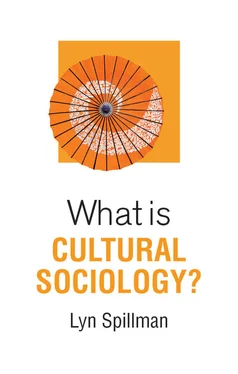Meanwhile, increasing European awareness of other peoples and exploration and conquest around the globe created a different, more comparative set of connotations to the idea of culture. The culture concept was used to emphasize and analyze differences among human populations. Especially for German thinkers such as eighteenth-century philosopher Johann Gottfried von Herder, “culture” became associated with the “whole way of life” of a group (Eagleton 2000, 12–13, 26). Sometimes, different cultures were seen as representing different stages of human progress, traceable through such features as means of subsistence, arts, beliefs, and religion (Kroeber and Kluckhohn 1963 [1952], 32). However, from the late nineteenth century, anthropologists pluralized and relativized the idea, recognizing that different cultures could not be evaluated according to a simple hierarchy – “culture” became “cultures” considered of equal value. This plural, relative, comparative sense of culture as a whole way of life was foundational in anthropology (Benedict 1959 [1934]; Kuper 1999; Ortner 1984; Stocking 1968).
This genealogy is still influential for popular understanding of “culture,” too. We are now very familiar with the idea that cultures are diverse, and similarly we usually assume that cultural possibilities are innumerable, that elements of a culture form interrelated patterns, and that these elements need to be placed in context to be understood. We might travel to experience “a different culture,” or celebrate diverse “cultures” in a city festival. These connotations all developed in anthropology and spread into common usage by the mid-twentieth century.
Because of this complex genealogy, the idea of culture is often used in quite different ways, even by the same person. Sometimes, following the first historical thread, you may use the term to refer to a distinct institutional realm of arts and humanities, different from – and maybe lesser or greater than – “practical” realms of politics and economics. At other times, following the second historical thread, you may use the term to characterize whatever is shared by a whole group, in contrast to other groups. Simply recognizing the genealogy of these connotations can help eliminate unnecessary confusion and ambiguity.
Until later in the twentieth century, sociologists also used the idea of culture quite loosely and ambiguously. Because, as Robert Nisbet has argued, “sociology, more than any other discipline, has taken on the conflicts between traditionalism and modernism in European culture” (1993 [1966], vii), culture was often seen in the first sense, as a separate realm of human life. On the other hand, the popularization of the anthropological idea that culture is a property distinguishing whole groups also influenced sociology, to the extent that twentieth-century sociology textbooks referred to “the anthropological idea of culture” for many years.
But even though sociology (unlike anthropology) was vague on the concept of culture for a long time, similar ideas flourished in other ways. All the classic sociological theorists were writing when the idea of culture was in flux, so they did not offer paradigmatic approaches to understanding “culture.” Nevertheless, all of them bequeathed related ideas and theoretical propositions that remain crucial, combining in different ways in later cultural sociology. Karl Marx showed how meaning-making could be important for domination, with his concept of ideology (Marx 1978 [1846]; see also Eagleton 1991; Wuthnow 1992). Max Weber established an important place for interpretive analysis in sociology and offered particular theories of social status and of historical rationalization which remain influential for cultural sociology (Weber 1998 [1904–5]; see also Schroeder 1992). Émile Durkheim provided the foundations of cultural analysis in sociology with his theories of collective conscience, collective representations, cognitive categories, and ritual (Durkheim 1995 [1912]; see also Alexander and Smith 2005). Georg Simmel contributed extensive reflections on the individual’s relation to surrounding culture by distinguishing objective and subjective culture (Simmel 1971; see also Frisby and Featherstone 1997). However, while all offered useful ways of thinking about cultural elements like rituals, symbols, evaluations, norms, and categories, they mostly did so only as a sideline in the course of answering other sorts of questions.
In the 1960s, a sociological best-seller encapsulated a fundamental cultural insight in its title – the central idea of “the social construction of reality . ” Authors Peter Berger and Thomas Luckmann aimed to provide a “sociological analysis of the reality of everyday life” (1966, 19). They applied insights from the twentieth-century sociology of knowledge, formerly devoted to what they called “theoretical thought,” to mundane settings – “what people ‘know’ as ‘reality’ in their everyday non- or pre-theoretical lives” (1966, 15). For this they drew on the phenomenologist Alfred Schutz for insight on common sense; they followed Weber’s emphasis on subjective meanings; they adopted some of Durkheim’s ideas about the impact of “social facts” for the individual; they modified Durkheim’s view with a more dynamic idea of dialectical influence between individual and society that they attributed to Marx; and they used George Herbert Mead’s symbolic interactionist understanding of socialization (Berger and Luckmann 1966, 16–17). Even though they avoided developing the concept of culture, their well-known work provided an undisputed position statement for sociologists interested in culture, cultural difference, and cultural conflict. The platform they offered for understanding meaning-making was widely adopted in sociology, and, as a result, what came to be called “social constructionism” came to be taken as sociological common ground (Vera 2016; for an extended critical assessment see Smith 2010, 119–206).
For Berger and Luckmann, structured patterns of social relations in groups are internalized by individuals in everyday life, and individuals then reproduce and sometimes change those patterns. For instance, an individual might internalize hierarchical family relations and then go on to live them out anew. Internalization is mediated by “signs” generated by surrounding social relations. So a child might understand family hierarchy through practical signs of interactional deference or explicit symbols of authority. This perspective on “the social construction of reality” synthesized disparate strands of social theory, from the macro to the micro – theories of objective social structure, theories of interaction, and phenomenological theories of subjective experience. Essentially, Berger and Luckmann offered a distinctively sociological vocabulary for understanding processes of meaning-making – in other words, for understanding “culture.”
So although sociologists were often vague about the concept of culture through the mid-twentieth century, they came to view what were essentially cultural processes through the lens of concepts like “ideology,” “collective conscience,” “interpretation,” and “the social construction of reality.” For some sociologists, the widespread acceptance of these ideas resolved uncertainties about analyzing culture. For many others, though, ideas like “the social construction of reality” were useful as signposts but opened more issues than they resolved. How does the dialectical social construction of reality operate in practice? What does this idea suggest about how to do sociological research on culture?
One intransigent issue was a theoretical impasse between conflict and consensus views of culture, between an emphasis on power and conflict, captured in the concept of ideology, and an emphasis on solidarity and consensus, as in the concept of collective conscience. Another recurring tension surrounded whether to focus on the influence of social structures (recurrent patterns of social relations) or on interactional processes (in which human agency and creativity might sometimes be seen). A third issue revolved around whether to highlight the interpretation of meanings themselves (as Weber did, for example, in his famous study of the Protestant Ethic [1998 (1904–5)]) or whether a genuinely sociological approach should minimize extended, thick interpretation of rituals, symbols, evaluations, norms, and categories and focus instead on external social forces which might explain them. These persistent issues – conflict vs. consensus, structure vs. agency, and interpretation vs. explanation – were all the more intransigent for sociologists interested in culture because “culture” was understood in broad, abstract terms as reflecting whole societies. Inquiries into such broad, abstract topics as “American culture” make it hard to even begin to answer specific questions about meaning-making.
Читать дальше












